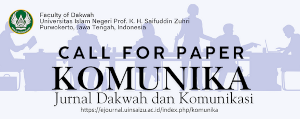HARMONISASI KELUARGA MELALUI KOMUNIKASI SETARA: MODEL TERAPI KELUARGA VIRGINIA SATIR
DOI:
https://doi.org/10.24090/komunika.v6i1.335Keywords:
Communication, Virginia Satir, and TheraphyAbstract
Communication is like two sides of a coin. On the one hand, communication is avital human tool, without which human beings would lose their function as social beings.However, on the other hand, communication is also often a source of contention, conflictand human tragedy. Therefore, it takes appropriate communication patterns, so thatcommunication does not become a boomerang for mankinds.In this context, Virginia Satir’s thought, a therapist for family problems, is worthyto be observed. Satir categorized communicators into five categories, i.e. Placater, Blamer,Computer (Super-Reasonable), Distractor, and Leveler (Interpersonal Communicator). Thefirst four types are communicators who lead to an incongruent communication. All fourwill only lead to conflict within the family as they communicate. The latter is thecongruent communicator: a leveler communicates in an equality setting. Satirrecommended people to use I-Message instead of You-Message communication patterns ifthe are to be levelers.Downloads
Download data is not yet available.
Downloads
Issue
Section
Articles
License
Authors who publish with this journal agree to the following terms:
- Authors retain copyright and grant the journal right of first publication with the work simultaneously licensed under a Creative Commons Attribution-ShareAlike 4.0 International License that allows others to share the work with an acknowledgement of the work's authorship and initial publication in this journal.
- Authors are able to enter into separate, additional contractual arrangements for the non-exclusive distribution of the journal's published version of the work (e.g., post it to an institutional repository or publish it in a book), with an acknowledgement of its initial publication in this journal.
- Authors are permitted and encouraged to post their work online (e.g., in institutional repositories or on their website) prior to and during the submission process, as it can lead to productive exchanges, as well as earlier and greater citation of published work (See The Effect of Open Access).
























